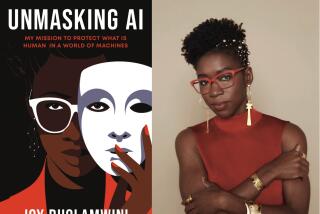This Anchor’s Pixel-Perfect--and Informative
- Share via
She has a cute shock of teal hair, a button nose and a voice once described as Barbie on Quaaludes. She moves. She emotes. She reads the latest news.
“Hi, there,” says Ananova, blinking her saucer eyes on the computer screen. “In the Philippines, negotiations continue over the fate of 21 hostages. . . .” Blink. Blink.
The news is real, but Ananova is not. She is a news droid, a virtual newscaster. She popped onto the World Wide Web (https://www.ananova.com) last month. Punch her “play” button and she’ll read you a smattering of up-to-the-minute news bytes, periodically refreshed by her creators at the British Press Assn. Ananova can wink, nod, raise an eyebrow, and express surprise or amusement as she tells the world about itself.
In other words, just like the real thing but without the hair spray and contract negotiations.
Ananova has received 1.6 million unique visitors, ranking Ananova.com among the most popular news sites. She is created and programmed in Leeds, England, but her most frequent hits come from Canada, the United States and Hong Kong. She has received two marriage proposals.
The flurry of interest suggests Ananova might be telling us something about the future of information. And maybe a little about the present.
Ananova is what computer scientists variously call an “agent” or “avatar.” She’s a mass of sophisticated speech-recognition software and computing power designed to put a human face--and personality--on our interactions with machines. The development of avatars (a Hindi term meaning “incarnation of a god”) reflects the obvious: People would rather interact with people--even ones who are only vaguely human--than with silicon and cold type.
Agents like Ananova could be the start of the inevitable march toward the “HAL-ization” of computing. Next month, Motorola will roll out a computer-driven character named Mya, a spike-haired female humanoid “cyber-assistant” that will read e-mail messages, stock quotes, news, sports scores and weather forecasts off the Internet via wireless and conventional phone connections.
At MIT’s famed Media Lab, professor Justine Cassell is developing Rea, a female real estate agent capable of providing spoken, “real-time” information from a vast housing database. (“How big is the kitchen, Rea?”) At USC’s Integrated Systems Center, work is progressing on what its director, Max Nikias, calls “immersive environments”--computerized worlds in which users create accurate representations of themselves (or perhaps improved versions of themselves) to interact with representations of others.
“People already know how to engage in face-to-face conversation with other people,” says Cassell. “I think people see in the advent of new technologies a chance for increased personalization in their everyday interaction with machines.”
The Press Assn.’s designers spent a year getting Ananova’s quasi-human appearance just so. Ananova is supposed to be the universal anchorwoman, engineered to inspire trust and credibility in computer users everywhere.
They made her white because Web surfers are predominantly white; they made her youthful because her anticipated audience is that too. They made her attractive but not a bimbo, a tad punkish but nonthreateningly so. Her solitary distinctive touch is the swatch of blue-green in her hair.
Ananova’s look and mannerisms are computerized riffs straight from the TV anchor’s playbook. See how Ananova looks serious and grave when talking about some foreign hot spot? See how her look changes to slightly amused when the story is light and inconsequential? See how she appears to be looking downward at you, as if she were literally on a pedestal?
*
“We looked to traditional news readers and the way they use visual punctuation,” said Mark Spanton, creative director of the association’s new-media arm, now known as Ananova Ltd. “It’s all pre-programmed in.” By this he means all stories are specially coded so Ananova displays the appropriate reaction as she reads.
Ananova is a she because her creators relied on research indicating that both sexes respond favorably to information and instructions from a feminine voice. James Earl Jones sets you up on Bell Atlantic directory assistance, but a woman’s voice provides the goods. Voicemail, the elevator announcement, the reminder that your luxmobile’s lights are still on--all are women’s voices. “2001: A Space Odyssey” author Arthur C. Clarke had it wrong in at least one respect: HAL will be a woman.
Despite her British roots, Ananova sounds more American than not, and a bit drugged at that. Ananova’s British creators couldn’t give her an English accent, not when the flat American variety is the de facto worldwide standard. The Press Assn. officially describes Ananova’s accent as mid-Atlantic.
The sophisticated text-to-voice software that enables Ananova to “speak” isn’t without flaws; in Ananova’s world, the IRA political party Sinn Fein is “sin fayn” instead of “shin fayn” and Mount Everest is “Mount Ev-her-hest.”
And because a pack of Brits feeds her the lines, Ananova can’t help but be culture-bound. She recently spoke of former Chilean dictator Augusto Pinochet as being “rushed to hospital,” a phrase no Yank would likely utter. On the other hand, she pronounces “Giuliani” with an accent that would impress a Brooklynite.
Veteran TV news consultant Al Primo finds Ananova “an interesting and clever way to present the news” if Web surfers warm up to her personality, such as it is.
“Ninety percent of any newscast is the newscaster,” says Primo, who invented the high-energy “Eyewitness News” format in the 1960s. “When you talk to focus groups, all the marks go to personality. Hardly anyone ever mentions the other stuff, like graphics and writing and camera work.”
*
To enhance her human “feel,” the Press Assn. has tricked up a back story for Ananova. She is 28, 5 feet 8, a “quietly intelligent” woman who enjoys sports statistics, “The Simpsons,” Mozart and Oasis, the perpetually disbanding British rock band.
“Does it replace humans as journalists? No, obviously not,” says Barbara Cochran, who heads the Radio and Television News Directors Assn. in Washington, D.C. “It’s backed by 500 journalists in the Press Assn. Someone is always going to have to gather the news and organize it. There’s always going to be someone who has to guarantee that the facts are accurate. You can’t do that with a puppet.”
Give technology time, though, and it could get interesting. Soon, Ananova will speak French and Dutch. Soon, she’ll be available via wireless devices such as cell phones, with an “on-demand” feature that will enable her to pop up and deliver information whenever you want it, wherever you are. Soon, users will be able to customize the newscast’s length, frequency and type of news delivered. Ultimately, all text material available on the Ananova site will be available in streaming video newscast form.
And Ananova will evolve as a “human.” Her creators promise we will someday see the “full” Ananova, not just from the collarbone up.
But all this could be mere tinkering compared with what’s coming. Someday, through the magic of advanced audio and video technology and super-fast Internet connections, you may be able to get your news from a digitally constructed “avatar” of your choosing, says USC’s Nikias.
Nikias says these lifelike human representations--anyone from Walter Cronkite to Pamela Anderson--could be programmed to move and talk in realistic but nonetheless artificial settings.
Of course, says Nikias, there will be a need for “checks and balances” on digital identities to ensure authenticity, or else everyone might start creating virtual president avatars and start declaring nuclear wars.
But consider the benefits: “Instead of writing text messages, as we do now,” he says, “we could create a chat room where my avatar can walk in, sit down and talk to your avatar.” Your avatar could be your daily newscaster, e-mail reader, weather forecaster and online shopper.
Imagine. In the future, the ultimate cyber robot could be . . . you.
More to Read
Sign up for The Wild
We’ll help you find the best places to hike, bike and run, as well as the perfect silent spots for meditation and yoga.
You may occasionally receive promotional content from the Los Angeles Times.






